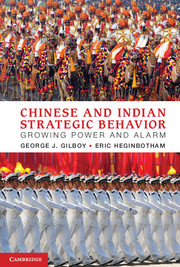Book contents
- Frontmatter
- Contents
- Figures
- Tables
- Acknowledgments
- Preface
- Abbreviations
- Map
- 1 Introduction
- 2 Strategic Culture
- 3 Foreign Policy, Use of Force, and Border Settlements
- 4 Military Modernization
- 5 Military Doctrine
- 6 Military Force Modernization and Power Projection
- 7 Economic Strategic Behavior
- 8 India, China, and Democratic Peace Theory
- 9 Meeting the Dual Challenge
- Appendix Defense Spending, Selected Additional Data
- Bibliography
- Index
- References
6 - Military Force Modernization and Power Projection
Published online by Cambridge University Press: 05 June 2012
- Frontmatter
- Contents
- Figures
- Tables
- Acknowledgments
- Preface
- Abbreviations
- Map
- 1 Introduction
- 2 Strategic Culture
- 3 Foreign Policy, Use of Force, and Border Settlements
- 4 Military Modernization
- 5 Military Doctrine
- 6 Military Force Modernization and Power Projection
- 7 Economic Strategic Behavior
- 8 India, China, and Democratic Peace Theory
- 9 Meeting the Dual Challenge
- Appendix Defense Spending, Selected Additional Data
- Bibliography
- Index
- References
Summary
With growing economic resources and newly developed military doctrines, India and China are both acquiring advanced weapons systems and new power projection capabilities. In this chapter, we compare overall trends in force modernization in both countries, including the development of military forces that can be used to project power. China’s developing military capabilities have become a key focus for U.S. defense planners, and American officials have questioned the motivation for China’s acquisition of power projection forces. These developments are seen as a potentially destabilizing factor in Asian military balances and as a possible indicator of an anti–status quo strategic posture. According to the U.S. National Defense Strategy 2008, “China is one ascendant state with the potential for competing with the United States. For the foreseeable future, we will need to hedge against China’s growing military modernization and the impact of its strategic choices upon international security.”
India too has been undertaking significant force modernization programs. In some ways, India’s power projection forces have long been more extensive than China’s. For example, India acquired its first aircraft carrier (the INS Vikrant, formerly HMS Hercules) in 1961 and has significant experience in carrier operations and naval patrolling. The Indian navy currently has one carrier in service and two under construction. For its part, China began sea trials for its first-ever aircraft carrier, a refurbished former Soviet Union ship, in 2011. India is also developing new amphibious warfare and maritime patrol capabilities and is conducting major upgrades to its air force, its missile strike capabilities, and the armor and artillery striking power of its ground forces.
- Type
- Chapter
- Information
- Chinese and Indian Strategic BehaviorGrowing Power and Alarm, pp. 164 - 208Publisher: Cambridge University PressPrint publication year: 2012



